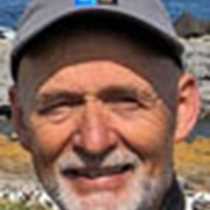Edgeøya, Svalbard
Our wake-up call this morning was accompanied by good news! Edgar, our sharp-eyed seaman, had spotted a big whale in Storfjorden, west of Edgeøya. The tall spout was proof of a fin whale – the second largest mammal on earth. This huge creature surfaced a number of times. This was to be just the overture to a symphony of impressions of Svalbard at its best: sea- and landscapes of the high Arctic. As we moved northwards to Edgeøya, we encountered Svalbard reindeer, arctic fox, numerous birds, a haul-out of walrus, a swimming polar bear and one big bear with its kill on ice; all framed by the beauty of majestic land forms, barren moraines, lush valleys and the colours of arctic flowers at peak blooming.
In the morning we set foot onshore at Rosenbergdalen, the first landing of our Svalbard exploration. At first glance the valley looked desolate. When looking down, however, we discovered pocket jewels of arctic flowers: moss campion, mountain avens, arctic cinquefoil, hairy lousewort and several saxifrage species. In addition, goose droppings showed it to be an important "gas station" for migrating geese. Most of us were fortunate to see arctic fox with a puppy running around a den on a grassy mound. This lush valley is truly a green heaven for the Svalbard reindeer. During our hike we counted more than twenty bucks, females and calves. By the time Norway was granted sovereignty over Svalbard, the reindeer population on the archipelago was close to extinction, after centuries of hunting. In previous centuries reindeer meat had been a key food supply for overwintering trappers. From the early days the trappers had divided Svalbard into 45 hunting territories, one of which was the northern half of Edgeøya, a very good hunting ground for polar bears and arctic foxes. So, the government´s very first measure based on the Svalbard Treaty was a total ban on reindeer hunting in 1925.
After lunch we made a landing at Dolerittbukta, just south of Kapp Lee. Beside an old met station two haul-outs of walrus males were gathered in untidy heaps. Close to 60 males shared their odours and sounds far from acceptable standards of human behaviour. Every time when one walrus raised its head or exposed its tusks, the cameras sounded click-click, click-click-click, like a busy press conference. We were happy to see how all this happened without any signs of stress from these animals.
As we walked back to the Zodiacs, we passed an enormous concentration of skulls, vertebrae and other bones from whales, walrus and polar bear. Today many of these bones are being covered by soil, forming colourful flowerbeds of tufted saxifrage. These beautiful arctic flowers are nourished by minerals from this dreadful graveyard. However, many of the overexploited species are now recovering, thanks to successful environmental action. Let us hope that the blooming saxifrage rising from the whale bone may inspire us all to care more for our beautiful planet.
Our wake-up call this morning was accompanied by good news! Edgar, our sharp-eyed seaman, had spotted a big whale in Storfjorden, west of Edgeøya. The tall spout was proof of a fin whale – the second largest mammal on earth. This huge creature surfaced a number of times. This was to be just the overture to a symphony of impressions of Svalbard at its best: sea- and landscapes of the high Arctic. As we moved northwards to Edgeøya, we encountered Svalbard reindeer, arctic fox, numerous birds, a haul-out of walrus, a swimming polar bear and one big bear with its kill on ice; all framed by the beauty of majestic land forms, barren moraines, lush valleys and the colours of arctic flowers at peak blooming.
In the morning we set foot onshore at Rosenbergdalen, the first landing of our Svalbard exploration. At first glance the valley looked desolate. When looking down, however, we discovered pocket jewels of arctic flowers: moss campion, mountain avens, arctic cinquefoil, hairy lousewort and several saxifrage species. In addition, goose droppings showed it to be an important "gas station" for migrating geese. Most of us were fortunate to see arctic fox with a puppy running around a den on a grassy mound. This lush valley is truly a green heaven for the Svalbard reindeer. During our hike we counted more than twenty bucks, females and calves. By the time Norway was granted sovereignty over Svalbard, the reindeer population on the archipelago was close to extinction, after centuries of hunting. In previous centuries reindeer meat had been a key food supply for overwintering trappers. From the early days the trappers had divided Svalbard into 45 hunting territories, one of which was the northern half of Edgeøya, a very good hunting ground for polar bears and arctic foxes. So, the government´s very first measure based on the Svalbard Treaty was a total ban on reindeer hunting in 1925.
After lunch we made a landing at Dolerittbukta, just south of Kapp Lee. Beside an old met station two haul-outs of walrus males were gathered in untidy heaps. Close to 60 males shared their odours and sounds far from acceptable standards of human behaviour. Every time when one walrus raised its head or exposed its tusks, the cameras sounded click-click, click-click-click, like a busy press conference. We were happy to see how all this happened without any signs of stress from these animals.
As we walked back to the Zodiacs, we passed an enormous concentration of skulls, vertebrae and other bones from whales, walrus and polar bear. Today many of these bones are being covered by soil, forming colourful flowerbeds of tufted saxifrage. These beautiful arctic flowers are nourished by minerals from this dreadful graveyard. However, many of the overexploited species are now recovering, thanks to successful environmental action. Let us hope that the blooming saxifrage rising from the whale bone may inspire us all to care more for our beautiful planet.



